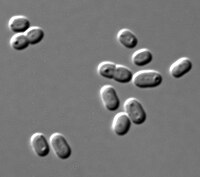
Photo from wikipedia
Photosynthetic organisms possess a variety of mechanisms to achieve balance between absorbed light (source) and the capacity to metabolically utilize or dissipate this energy (sink). While regulatory processes that detect… Click to show full abstract
Photosynthetic organisms possess a variety of mechanisms to achieve balance between absorbed light (source) and the capacity to metabolically utilize or dissipate this energy (sink). While regulatory processes that detect changes in metabolic status/balance are relatively well studied in plants, analogous pathways remain poorly characterized in photosynthetic microbes. Here, we explored systemic changes that result from alterations in carbon availability in the model cyanobacterium Synechococcus elongatus PCC 7942 by taking advantage of an engineered strain where influx/efflux of a central carbon metabolite, sucrose, can be regulated experimentally. We observed that induction of a high-flux sucrose export pathway leads to depletion of internal carbon storage pools (glycogen) and concurrent increases in estimates of photosynthetic activity. Further, a proteome-wide analysis and fluorescence reporter-based analysis revealed that upregulated factors following the activation of the metabolic sink are concentrated on ribulose-1,5-bisphosphate carboxylase-oxygenase (Rubisco) and auxiliary modules involved in Rubisco maturation. Carboxysome number and Rubisco activity also increased following engagement of sucrose secretion. Conversely, reversing the flux of sucrose by feeding exogenous sucrose through the heterologous transporter resulted in increased glycogen pools, decreased Rubisco abundance, and carboxysome reorganization. Our data suggest that Rubisco activity and organization are key variables connected to regulatory pathways involved in metabolic balancing in cyanobacteria.
Journal Title: Plant physiology
Year Published: 2022
Link to full text (if available)
Share on Social Media: Sign Up to like & get
recommendations!